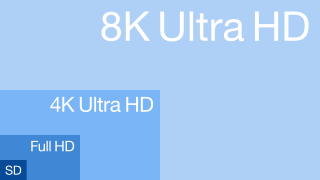
Red Digital Cinema, LLC is an American camera manufacturer specializing in digital cinematography headquartered in Foothill Ranch, California, United States. It has been owned by Nikon since April 2024.

Digital cinematography is the process of capturing (recording) a motion picture using digital image sensors rather than through film stock. As digital technology has improved in recent years, this practice has become dominant. Since the 2000s, most movies across the world have been captured as well as distributed digitally.

A motion picture film scanner is a device used in digital filmmaking to scan original film for storage as high-resolution digital intermediate files.

Digital Imaging Integrated Circuit is Canon Inc.'s name for a family of signal processing and control units for digital cameras and camcorders. DIGIC units are used as image processors by Canon in its own digital imaging products. Several generations of DIGICs exist, and are distinguished by a version number suffix.

CinemaDNG is the result of an Adobe-led initiative to define an industry-wide open file format for digital cinema files. CinemaDNG caters for sets of movie clips, each of which is a sequence of raw video images, accompanied by audio and metadata. CinemaDNG supports stereoscopic cameras and multiple audio channels. CinemaDNG specifies directory structures containing one or more video clips, and specifies requirements and constraints for the open format files,, within those directories, that contain the content of those clips.

The Arri Alexa is a digital motion picture camera system developed by Arri. The Arri Alexa was introduced in April 2010 and was Arri's first major transition into digital cinematography, after previous efforts including the Arriflex D-20 and D-21.

4K resolution refers to a horizontal display resolution of approximately 4,000 pixels. Digital television and digital cinematography commonly use several different 4K resolutions. In television and consumer media, 3840 × 2160 with a 16:9 aspect ratio is the dominant 4K standard, whereas the movie projection industry uses 4096 × 2160.

8K resolution refers to an image or display resolution with a width of approximately 8,000 pixels. 8K UHD is the highest resolution defined in the Rec. 2020 (UHDTV) standard.

Blackmagic Design Pty Ltd is an Australian digital cinema company and manufacturer based in Port Melbourne, Victoria, Australia. It designs and produces broadcast and cinema-grade hardware; notably, high-end digital movie cameras, and also develops video editing software, such as the DaVinci Resolve and Blackmagic Fusion applications.
Apple ProRes is a high quality, "visually lossless" lossy video compression format developed by Apple Inc. for use in post-production that supports video resolution up to 8K. It is the successor of the Apple Intermediate Codec and was introduced in 2007 with Final Cut Studio 2. Much like the H.26x and MPEG standards, the ProRes family of codecs use compression algorithms based on the discrete cosine transform (DCT). ProRes is widely used as a final format delivery method for HD broadcast files in commercials, features, Blu-ray and streaming.

5K resolution refers to display formats with a horizontal resolution of around 5,000 pixels. The most common 5K resolution is 5120 × 2880, which has an aspect ratio of 16∶9 with around 14.7 million pixels, with exactly twice the linear resolution of 1440p and four times that of 720p. This resolution is typically used in computer monitors to achieve a higher pixel density, and is not a standard format in digital television and digital cinematography, which feature 4K resolutions and 8K resolutions.

The Blackmagic Cinema Camera is a digital movie camera developed and manufactured by Blackmagic Design and released on September 4, 2012. It is part of the Cinema Camera family of digital movie cameras and shoots 2.5K video in raw, Apple ProRes, CinemaDNG and Avid DNxHD formats.
The Blackmagic URSA is a digital movie camera developed and manufactured by Blackmagic Design, released on August 8, 2014. It is the first camera to be user-upgradeable for additional equipment manufactured by Blackmagic and other third-party makers.

DaVinci Resolve is a proprietary color grading, color correction, visual effects, and audio post-production video editing application for macOS, Windows, and Linux, developed by Australian company Blackmagic Design. It was originally developed by American company Da Vinci Systems under the name da Vinci Resolve until 2009, when Blackmagic Design acquired the company. In addition to the commercial version of the software, Blackmagic Design also distributes a free edition with reduced functionality, simply named DaVinci Resolve.
32K resolution refers to a display resolution of approximately 32,000 pixels horizontally. A resolution of 30720 × 17280 for an aspect ratio of 16:9 is speculated to be standardized. This doubles the pixel count of 16K in each dimension, for a total of 530.8 megapixels, 4 times as many pixels as the 16K resolution. It has 16 times as many pixels as 8K resolution, 64 times as many pixels as 4K resolution, 256 times the pixels as Full HD or 1080p resolution, and 576 times the pixels as HD or 720p resolution.
The Blackmagic Pocket Cinema Camera is a line of digital movie cameras developed and manufactured by Blackmagic Design and was first released 2013.











